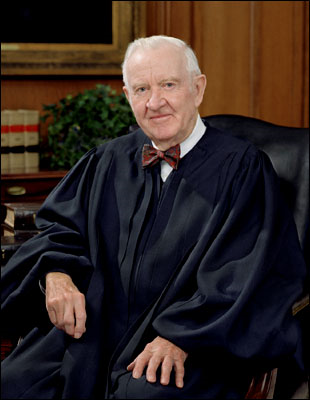Where Have You Gone, Justice Stevens?
The Supreme Court Misses Justice Stevens’ Influence & Perspective on Environmental Law
 With the commencement of the U.S. Supreme Court’s new Term, it’s appropriate to note–and bemoan–the absence of a strong environmental voice on the Court these days. Until his retirement in 2010 after a quarter century on the Court, Justice John Paul Stevens ably served in that role. By contrast, none of the current justices seems particularly interested in environmental law, much less willing to serve as a strong voice on the Court for environmental principles. And that’s a most unfortunate void–both on the Court and for environmental law in general.
With the commencement of the U.S. Supreme Court’s new Term, it’s appropriate to note–and bemoan–the absence of a strong environmental voice on the Court these days. Until his retirement in 2010 after a quarter century on the Court, Justice John Paul Stevens ably served in that role. By contrast, none of the current justices seems particularly interested in environmental law, much less willing to serve as a strong voice on the Court for environmental principles. And that’s a most unfortunate void–both on the Court and for environmental law in general.
There was little in Justice Stevens’ background to suggest that he would be the most influential justice on environmental law matters in the past century. But in a series of decisions for the Court, Stevens created an enormously influential body of Supreme Court precedent covering a wide array of federal environmental laws and principles. They include Chevron U.S.A. v. Natural Resources Defense Council, a hugely influential case involving the Clean Air Act and foundational principles of administrative law; Burlington Northern & Santa Fe Railway Co. v. United States, interpreting key provisions of CERCLA; Babbitt v. Sweet Home Chapter of Communities for a Greater Oregon, giving full force and effect to the habitat preservation provisions of the Endangered Species Act; E.I. du Pont de Nemours & Co. v. Train, which upheld the EPA’s basic approach in implementing the Clean Water Act; Marsh v. Oregon Natural Resources Council, supporting a “hard look” at agency efforts to implement NEPA; Tahoe-Sierra Preservation Council v. Tahoe Regional Planning Agency, which rejected a sweeping Takings Clause challenge to regional land use regulation; and Massachusetts v. USEPA, declaring greenhouse gases fully subject to regulation under the Clean Air Act.
In contrast, no current Supreme Court justice seems interested in carrying on Stevens’ formidable environmental legacy. An increasing number of environmental decisions by the Court in recent years have been unanimous, almost all in favor of business interests or rejecting legal challenges brought by environmental organizations against government regulators. (For example, five of last Term’s six environmental decisions were decided unanimously, all in favor of the regulated community.)
To be sure, the progressive members of the current Court sometimes exercise behind-the-scenes influence, writing or lobbying for more moderate opinions in environmental cases than would otherwise have been issued had the Court’s more conservative justices were voting and writing in unfettered fashion. Justice Ginsburg in particular has served in this moderating role in such recent cases as American Electric Power Co. v. Connecticut and Arkansas Game & Fish Commission v. United States.
But strong intellectual and political leadership in environmental cases among the Court’s current membership? Not so much. It’s for that reason that conservation organizations have strained mightily to keep their cases away from the justices in recent years. And environmental regulators at all levels of government have similar reasons to be very concerned if and when their cases find themselves on the Supreme Court’s docket.
As Legal Planet colleague Ann Carlson posted earlier today, the justices appear poised to grant review in a major climate change/Clean Air Act case from the D.C. Circuit Court of Appeals. If certiorari is indeed granted–and I agree with Ann that that’s a distinct possibility–this will be the most important environmental case coming before the Supremes since at least 2007, when Justice Stevens led the Court in deciding Massachusetts v. USEPA. But unless one or more of the current justices picks up Stevens’ environmental mantle, I fear that the nation’s efforts to combat climate change and confront a host of other environmental challenges will find precious little support in the Supreme Court in the foreseeable future.
To paraphrase Paul Simon:
Where have you gone, Justice Stevens? The environment turns a nervous eye to you…
Reader Comments
One Reply to “Where Have You Gone, Justice Stevens?”
Comments are closed.






What’s that you say, Justice Roberts, son? The greener John has left and gone away?